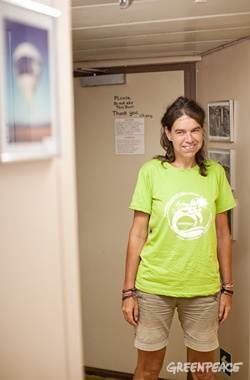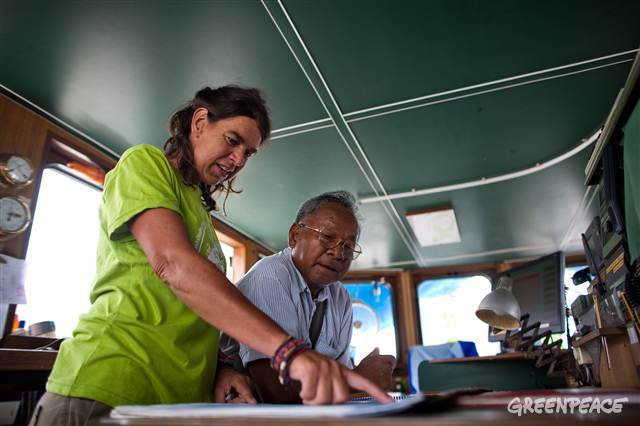
Our very able Chief Mate, the ship’s second-in-command, hails from Holland.
Hettie has been sailing with Greenpeace for 11 years now, but the last time she has been with the Rainbow Warrior was in 2001. Prior to that, she was working on tourist sailing vessels, but wanted to be able to do more for the world using her skills. And so she found Greenpeace.
For Hettie, every trip is a very different experience. She recounts that her first Greenpeace tour, visiting Thailand, India and the Philippines, was filled with enthusiastic welcoming ceremonies and eager, positive receptions. “I thought everywhere we would go, it would be that way, that we would always be welcome,” Hettie says. “But I soon realized how difficult our mission is, how complicated it is to communicate the problems. The following tour, aboard the Arctic Sunrise in Greenland, people would be throwing eggs at us. And I can understand where they are coming from. But we really need to continue despite the challenges.”
Hettie says her first trip on board the Rainbow Warrior, during the Toxics-Free Asia Tour in 2000, which was also the Warrior’s first foray into Southeast Asia, made a really big impression on her. She was 3rd Mate at that time, and shared the hospital cabin with the medic then, Paula, who occupied the upper bunk.
During that tour, a visit to the Philippines highlighted the effects of toxic wastes coming from the former US Naval Base in Subic, Olongapo, on the local people, especially on children who were born with medical conditions. Among those children visited by the Rainbow Warrior who were invited to go on board, was Crizel, who was born with a blood condition. The six-year old girl was already very weak and fragile at the time. But she said that it was her dream to be able to go aboard the Rainbow Warrior and experience the vast open sea and wide blue skies.

In that short amount of time, Hettie and the rest of the crew grew fond of the brave little girl. Though weak, Crizel was really adamant about being able to ride the inflatable boat with the other kids, and was even able to keep herself strong and alert enough to try her hand at piloting the boat for a little while. She was already very weak though, and shortly had to be brought back to the ship hospital to rest. The boat continued to give the remaining kids an experience on the waves.
While the inflatable boat was giving the kids a ride around the Subic Port where the Rainbow Warrior had anchored, a US Navy destroyer was keeping its eyes on the small Greenpeace boat, apparently preparing to fire water cannons at it. The Rainbow Warrior captain, who was an American, kept telling the US Navy over the radio intercom how ashamed he was to be a citizen from a big country, with a big warship that is claiming to keep the world safe, but would just as readily fire its big cannons at an innocent little boat carrying sick, small children. The destroyer backed down.
Back in the ship’s hospital cabin, a very happy but weakened Crizel slept in a bunk, with her mother and the ship’s nurse keeping her company. She never woke up again. Her equally brave mother would then be the one reassuring the devastated ship crew that she and her daughter were very thankful for her last moments, which became the fulfilment of a dream.
Hettie and the crew were profoundly affected by the enthusiasm, optimism and energy of a dying little girl who simply wanted to look at the world from a different perspective in her last hours. It gave focus to the many reasons why we in Greenpeace do what we do. “Of course, we cannot change the world overnight or with just one ship tour. But we should remember that the smallest thing we do helps,” Hettie reminds us.

